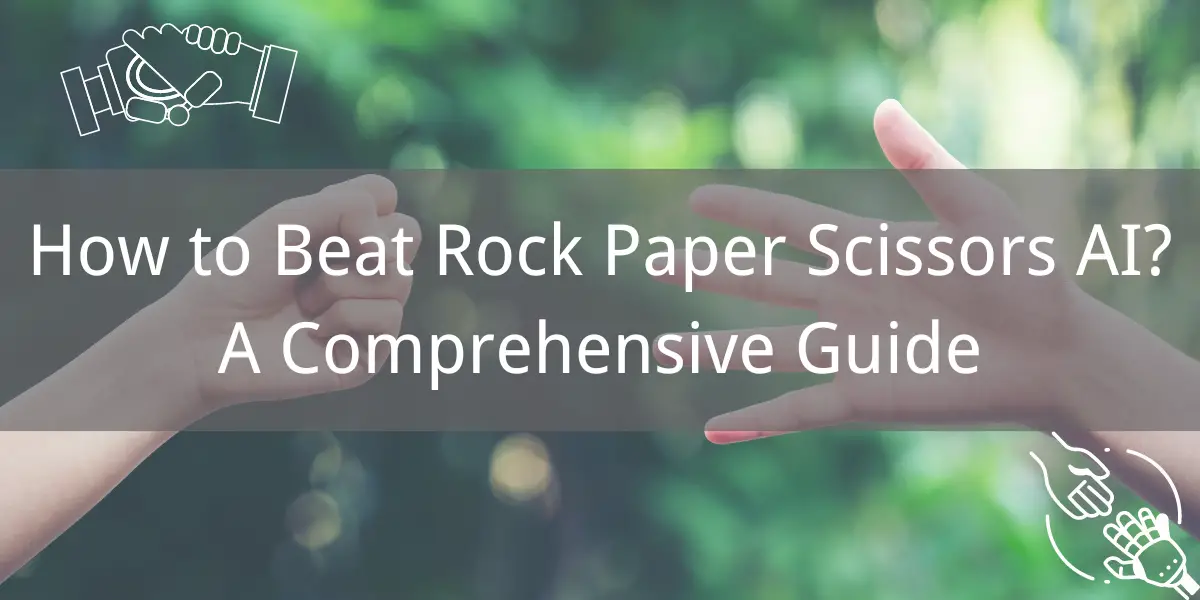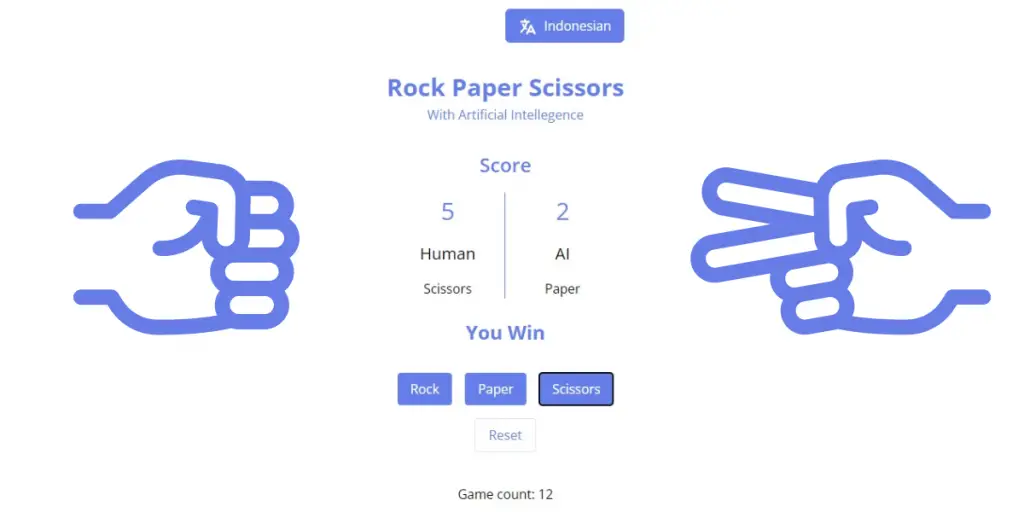How to Beat Rock Paper Scissors AI? A Comprehensive Guide

Hey there, future business mogul! In the age of startups and digital revolutions, naming your business can be as challenging as setting it up. But, thanks to some nifty AI tools, the naming process has become a breeze. Let’s dive deep into one such tool that’s making waves in 2023 – BeFake AI.
BeFake AI is redefining the boundaries of social networking. Merging the concepts of BeReal with the power of AI, it offers a platform for users to express their authentic creativity. Dive into the world of AI-augmented photos and discover a community of like-minded creators.
Table of Contents
What is Rock Paper Scissors AI?

Rock Paper Scissors AI refers to the application of artificial intelligence to the classic game of Rock, Paper, Scissors (RPS). In this digital version, players compete against a computer algorithm that is designed to predict and counter the player’s moves based on machine learning and pattern recognition technologies. Unlike traditional RPS, where the outcome is based on random selections, the AI analyzes data from previous rounds to make educated guesses, enhancing its strategies over time. This advanced technology not only makes the game more challenging but also transforms it into a test of strategy, pattern identification, and adaptability.
Key Features of Beat Rock Paper Scissors AI
Adaptive Learning Capabilities
AI continually improves its gameplay by learning from each match.
- Analyzes player’s move patterns.
- Adjusts its strategies based on past outcomes.
- Enhances accuracy of predictions over time.
Real-Time Decision Making
The AI responds instantaneously to player moves, making the game dynamic and engaging.
- Processes information and selects moves within milliseconds.
- Adapts to changes in player strategy during the game.
- Uses advanced algorithms to predict player behavior.
User-Friendly Interface
The AI is designed with an intuitive interface that facilitates easy interaction.
- Simple, clear options for choosing moves.
- Visual indicators of AI and player choices.
- Feedback loops that help players understand AI decisions.
Difference between Rock Paper Scissors AI and real people
Rock Paper Scissors AI differs significantly from its human counterparts. Where human players rely on intuition and random choice, AI systems utilize algorithms to determine their moves.
- Predictability vs. Spontaneity: AI follows programmed patterns and statistical analysis, unlike humans who can make spontaneous and sometimes illogical choices.
- Consistency: AI maintains consistent performance without psychological influences such as overconfidence or frustration.
- Learning Ability: Over time, AI can develop an understanding of the player’s style and adapt, a process that is faster and data-driven compared to human learning which is based on experience and memory.
How to play with Beat Rock Paper Scissors AI?
Playing against Rock Paper Scissors AI involves more than just randomly throwing signs. It requires a strategic approach to outsmart the AI’s pattern-recognition capabilities.
- Develop a strategy that appears random to avoid predictable patterns.
- Pay attention to the AI’s tendencies and adapt your strategy accordingly. If the AI seems to favor one move, prepare to counter it.
- Use a mix of consistent patterns and sudden changes to confuse the AI, testing its ability to adapt.
- Remember that the AI is learning from you just as you are trying to decode its patterns. Keep your strategy flexible and ready to evolve as the game progresses.
How does Rock Paper Scissors AI learn from humans?
Rock Paper Scissors AI leverages machine learning technologies to adapt and improve its game against human opponents. Through iterative gameplay, the AI identifies patterns in human choices and refines its predictions and strategies over time.
Pattern Detection
AI identifies recurring sequences in player choices to predict future moves.
- Collect data from each round to analyze player behavior.
- Identify common sequences or recurring choices made by the player.
- Use statistical analysis to predict the most likely next move of the player.
Strategy Optimization
AI continuously improves its strategies based on outcomes and player tendencies.
- Adjust strategies after each game based on wins and losses.
- Simulate different strategies in virtual environments to find the most effective ones.
- Implement the refined strategies in real games to test against human players.
Learning Adaptation
AI adapts its learning process based on the complexity of the player’s strategies.
- Analyze the effectiveness of current AI strategies and identify areas for improvement.
- Adapt the learning algorithms to focus on more complex patterns if simple patterns are easily deciphered by players.
- Continue to evolve the learning process to maintain a competitive edge against improving human strategies.
How to beat Rock Paper Scissors AI?

Beating Rock Paper Scissors AI involves understanding its learning and prediction capabilities and strategically outmaneuvering it.To gain the upper hand against an AI opponent in Rock Paper Scissors, players must employ unpredictability and strategic inconsistency.
- Randomness: Use a truly random strategy to prevent the AI from detecting patterns.
- Variability: Switch strategies frequently to keep the AI guessing and unable to settle on a predictive model.
- Psychological Play: Introduce bluffing and misleading patterns to exploit the AI’s expectation for logical play.
History and Development of Rock Paper Scissors AI
The evolution of Rock Paper Scissors AI reflects broader developments in artificial intelligence and game theory.
Origins and Early Development
The conceptual roots of RPS AI can be traced back to early experiments in game theory and computer science.
- Initial development focused on simple decision-making algorithms.
- Early versions were used in academic settings to demonstrate basic AI capabilities.
- Enhancements incorporated machine learning to improve decision accuracy.
Technological Advancements
As technology advanced, so did the capabilities of RPS AI.
- Implementation of more complex algorithms such as neural networks.
- Integration with more sophisticated forms of pattern recognition.
- Use of big data analytics to refine strategies based on large datasets of human play.
Cultural and Competitive Impact
RPS AI has made significant impacts both culturally and in competitive settings.
- Adoption in competitive gaming and online platforms.
- Influence on popular culture through media and entertainment.
- Use as a tool for teaching AI and game theory principles in educational contexts.
Resources and Support for Rock Paper Scissors AI
Support for Rock Paper Scissors AI enthusiasts and developers is readily available through various channels.
- Access to online communities where players can discuss strategies, challenges, and developments in RPS AI.
- Availability of open-source projects and code repositories that offer customizable RPS AI systems for coding and development.
- Educational resources including tutorials, courses, and webinars that teach the fundamentals of AI as applied to games like Rock Paper Scissors.
- Participation in competitions and hackathons that encourage the development of innovative AI strategies in RPS games.
Conclusion
In this comprehensive guide, we’ve explored the intricate world of Rock Paper Scissors AI, delving into its mechanics, strategies, and the subtle nuances that distinguish it from human play. We’ve uncovered the AI’s ability to learn from human opponents, adapt its strategies, and continuously refine its tactics through advanced machine learning technologies. By understanding the key features of RPS AI, such as its adaptive learning capabilities, real-time decision making, and user-friendly interface, players can better prepare themselves to face this digital challenger.
Moreover, we’ve discussed effective strategies for competing against RPS AI, emphasizing the importance of randomness and strategic unpredictability to counter the AI’s pattern recognition abilities. The historical context provided helps us appreciate the evolution of this game from a simple pastime to a complex field of study in artificial intelligence, highlighting significant technological advancements and cultural impacts.
As we look forward, the resources and support available for enthusiasts and developers will continue to expand, fostering a vibrant community eager to push the boundaries of what RPS AI can achieve. Whether you’re a casual player seeking to improve your game or a developer interested in the intricacies of AI implementation, the world of Rock Paper Scissors AI offers endless opportunities for exploration and mastery. Embrace the challenge, and may your decisions be as calculated as they are fortuitous.

